Best Camera Under $500 in 2023
There is an incredible variety of used cameras available under $500. Knowing the specifics of your needs can allow you to find a high end camera or one that was designed for a specific type of photography.
For instance a Panasonic GH4 for video or Sony A7, Sony A7 II for a mirrorless full frame, or Canon EOS M50 mark II for a small hybrid travel shooter.
For example the needs of someone that wants to do street photography will have different camera requirements than someone that wants to shoot indoor sports. Landscape photographers might make some sacrifices to get a camera body that is weather-sealed.
With such a large selection, knowing your specific needs can help you find a camera that is a great value. Below will be popular models that cover the vast majority of what people need from a camera.
The price breakdown will not include the cost of lenses. For all camera systems, mirrorless or DSLSRs, a kit lens or standard prime can be found for less than $150.
Affiliate Links
Outside the Shot is a participant in the Amazon Services LLC Associates Program, an affiliate advertising program designed to provide a means for sites to earn advertising fees by advertising and linking to Amazon.com.
As an eBay Partner, I may be compensated if you make a purchase. I also participate in affiliate advertising programs with KEH and Adorama. More can be found on the Affiliate Discolsure page.
I have purchased gear from all of these companies and I expect them all to receive repeat business from me.
I’m Rebuilding 🏗️
If the page doesn’t have the answer you’re looking for you can email me at contact AT this domain. That account will be checked on Sundays and Wednesdays.
You can also DM me on Reddit /u/OutsideTheShot or post in /r/OutsideTheShot.
Canon
To get a handle on the market I looked at the completed eBay sold listings for canon cameras between $400-$500. Those prices are helpful for setting a reference point when you check prices on other sites.
Canon EOS M50 Mark II
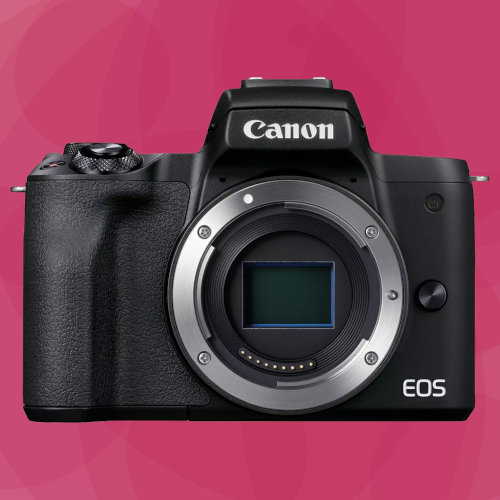
The Canon EOS M50 Mark II is a versatile, compact, and user-friendly mirrorless camera, perfect for both beginners and experienced photographers. Building upon the successful foundation of its predecessor, the M50 Mark II offers several improvements and upgraded features.
See current price and more information on:
Key specifications:
- 24.1-megapixel APS-C CMOS sensor
- DIGIC 8 image processor
- Dual Pixel CMOS AF with 143 AF points
- ISO range of 100-25,600 (expandable to 51,200)
- 4K UHD video recording at 24p (with 1.6x crop)
- Full HD 1080p video recording up to 60p
- 10 fps continuous shooting with AF-S (7.4 fps with AF-C)
- Built-in electronic viewfinder (EVF) with 2.36 million dots
- 3-inch vari-angle touchscreen LCD
- Wi-Fi and Bluetooth connectivity for easy image transfer
Comparisons:
-
Canon EOS M50 Mark II vs Canon EOS M50: The M50 Mark II offers several improvements over its predecessor, such as faster autofocus, improved eye detection, vertical video support, and the ability to livestream directly to YouTube. However, both cameras share the same sensor, processor, and overall design.
-
Canon EOS M50 Mark II vs Sony a6400: The Sony a6400 offers a higher resolution viewfinder, faster continuous shooting (11 fps), and superior low-light performance with an ISO range up to 102,400. However, the M50 Mark II has a fully articulating touchscreen, whereas the a6400’s screen only tilts. The Canon’s user interface is more beginner-friendly, while the Sony offers more customization options for advanced users.
-
Canon EOS M50 Mark II vs Fujifilm X-T30: Both cameras have 24.1-megapixel APS-C sensors and comparable image quality. The Fujifilm X-T30 offers a more extensive ISO range (up to 51,200), faster continuous shooting (up to 20 fps with electronic shutter), and 4K video recording at 30p without a crop. However, the M50 Mark II has a more user-friendly touchscreen interface, better autofocus performance, and a fully articulating screen.
Canon EOS Rebel T7 / EOS 2000D
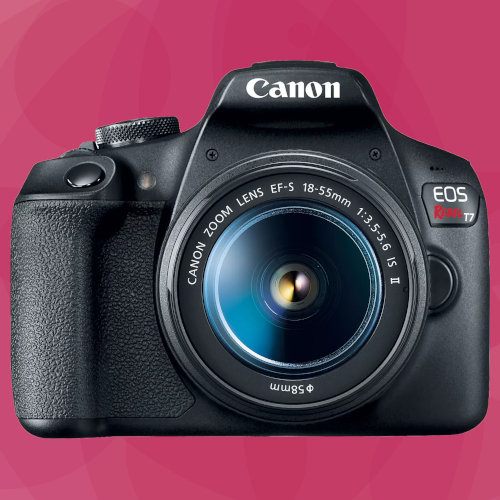
The Canon EOS Rebel T7, also known as the EOS 2000D, is an entry-level DSLR aimed at beginner photographers who are seeking an affordable and easy-to-use camera with solid performance.
See current price and more information on:
Key specifications:
- 24.1-megapixel APS-C CMOS sensor
- DIGIC 4+ image processor
- 9-point autofocus system
- ISO range of 100-6,400 (expandable to 12,800)
- Full HD 1080p video recording at 30p
- 3 fps continuous shooting
- 3-inch fixed LCD screen with 920k dots
- Built-in Wi-Fi and NFC connectivity for easy image transfer
Comparisons:
-
Canon EOS Rebel T7 vs Canon EOS Rebel T6 (1300D): The Rebel T7 offers a higher resolution sensor (24.1 MP vs 18 MP), which results in improved image quality and better detail. Both cameras share the same DIGIC 4+ image processor, 9-point AF system, and ISO range, but the T7’s upgraded sensor makes it a better choice for those seeking improved image quality.
-
Canon EOS Rebel T7 vs Nikon D3500: The Nikon D3500 has a similar 24.2-megapixel APS-C sensor and a faster EXPEED 4 image processor. The D3500 offers better low-light performance with an ISO range up to 25,600 and a faster continuous shooting rate of 5 fps. Additionally, the D3500 has a longer battery life (1,550 shots per charge) compared to the T7 (500 shots per charge). However, the T7 has built-in Wi-Fi and NFC connectivity, while the D3500 relies on Bluetooth for wireless image transfer.
-
Canon EOS Rebel T7 vs Canon EOS Rebel SL3 (250D): The Rebel SL3 is a more advanced and compact camera, featuring a 24.1-megapixel APS-C sensor with a faster DIGIC 8 image processor. It also has a more sophisticated 9-point AF system with Dual Pixel CMOS AF, enabling smoother and more accurate autofocus in live view and video recording. The SL3 offers 4K video recording at 24p, a higher-resolution 3-inch vari-angle touchscreen LCD, and a faster continuous shooting rate of 5 fps. In contrast, the Rebel T7 is more affordable and has a simpler interface, making it more accessible to beginners.
Canon EOS 80D
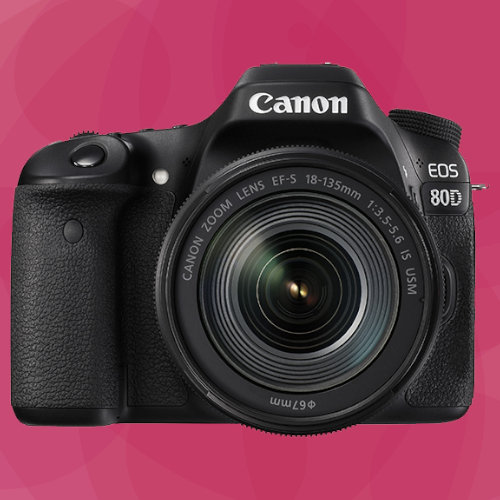
The Canon EOS 80D is a mid-range DSLR camera aimed at enthusiast photographers seeking a feature-rich camera with excellent image quality and performance.
See current price and more information on:
Key specifications:
- 24.2-megapixel APS-C CMOS sensor
- DIGIC 6 image processor
- 45-point all cross-type autofocus system
- Dual Pixel CMOS AF for live view and video
- ISO range of 100-16,000 (expandable to 25,600)
- Full HD 1080p video recording at 60p
- 7 fps continuous shooting
- 3-inch vari-angle touchscreen LCD with 1.04 million dots
- Built-in Wi-Fi and NFC connectivity for easy image transfer
Comparisons:
-
Canon EOS 80D vs Canon EOS 70D: The EOS 80D offers several improvements over its predecessor, the 70D. These include a higher resolution sensor (24.2 MP vs 20.2 MP), an upgraded 45-point all cross-type AF system (compared to the 70D’s 19-point system), and better low-light performance with an expanded ISO range. The 80D also has a slightly faster continuous shooting rate of 7 fps compared to the 70D’s 6 fps.
-
Canon EOS 80D vs Nikon D7200: Both cameras have similar specifications, with 24.2-megapixel APS-C sensors and robust autofocus systems. However, the D7200 has a slightly wider ISO range (100-25,600, expandable to 102,400) and a faster continuous shooting rate at 6 fps (7 fps in 1.3x crop mode). The 80D, on the other hand, features a fully articulating touchscreen and the advanced Dual Pixel CMOS AF system for smoother and more accurate autofocus during live view and video recording.
-
Canon EOS 80D vs Canon EOS 7D Mark II: The 7D Mark II is positioned as a more advanced camera, featuring a 20.2-megapixel APS-C sensor and a 65-point all cross-type AF system. It also boasts a faster continuous shooting rate of 10 fps, making it better suited for action and sports photography. The 7D Mark II has a more robust build and is better weather-sealed compared to the 80D. However, the 80D has a higher resolution sensor, a fully articulating touchscreen, and the Dual Pixel CMOS AF system, which can be advantageous for live view and video shooting.
Nikon
Here is a link to the $400-$500 Nikon camera sold listings on eBay.
Nikon D3500
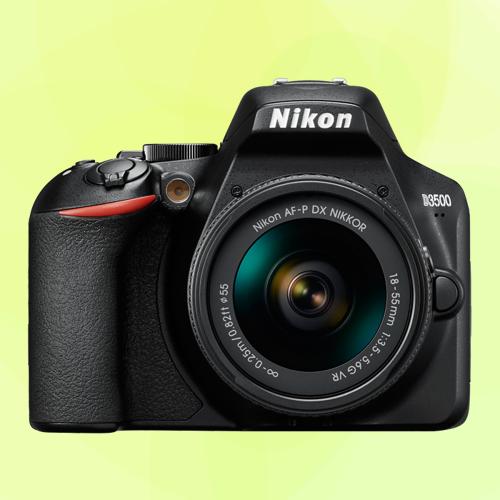
The Nikon D3500 is an entry-level DSLR camera aimed at beginners who are looking for an affordable and user-friendly option that still offers solid performance and image quality.
See current price and more information on:
Key specifications:
- 24.2-megapixel APS-C CMOS sensor
- EXPEED 4 image processor
- 11-point autofocus system with one cross-type point
- ISO range of 100-25,600
- Full HD 1080p video recording at 60p
- 5 fps continuous shooting
- 3-inch fixed LCD screen with 921k dots
- Bluetooth connectivity for easy image transfer
- Long battery life: up to 1,550 shots per charge
#Comparisons:
-
Nikon D3500 vs Nikon D3400: The D3500 offers a few improvements over its predecessor, the D3400, such as a more ergonomic grip, a longer battery life (1,550 shots per charge compared to 1,200), and a slightly lighter body. The two cameras share the same sensor, image processor, and overall performance.
-
Nikon D3500 vs Canon EOS Rebel T7 (2000D): Both cameras are aimed at beginner photographers and feature similar 24-megapixel APS-C sensors. The D3500 has a faster EXPEED 4 image processor, a higher maximum ISO (25,600 compared to the T7’s 12,800), and a faster continuous shooting rate (5 fps vs 3 fps). Additionally, the D3500 boasts a longer battery life (1,550 shots per charge compared to the T7’s 500 shots). However, the Canon T7 offers built-in Wi-Fi and NFC connectivity, while the D3500 relies on Bluetooth for wireless image transfer.
-
Nikon D3500 vs Nikon D5600: The D5600 is a mid-range DSLR with several notable upgrades compared to the D3500. It features a more advanced 39-point AF system with 9 cross-type points, a fully articulating 3.2-inch touchscreen LCD, and built-in Wi-Fi and NFC connectivity. The D5600 also offers more advanced features such as time-lapse video and exposure bracketing. In contrast, the D3500 has a more straightforward user interface and is more affordable, making it more accessible to beginners.
Nikon D5600

The Nikon D5600 is a mid-range DSLR camera aimed at photographers seeking a versatile and feature-rich camera that offers excellent image quality and performance.
See current price and more information on:
Key specifications:
- 24.2-megapixel APS-C CMOS sensor
- EXPEED 4 image processor
- 39-point autofocus system with 9 cross-type points
- ISO range of 100-25,600
- Full HD 1080p video recording at 60p
- 5 fps continuous shooting
- 3.2-inch fully articulating touchscreen LCD with 1.037 million dots
- Built-in Wi-Fi and NFC connectivity, with Bluetooth for easy image transfer
- SnapBridge app for seamless smartphone integration
Comparisons:
-
Nikon D5600 vs Nikon D5500: The D5600 offers several improvements over its predecessor, the D5500, such as the SnapBridge app for seamless smartphone integration, improved time-lapse video functionality, and a longer battery life (820 shots per charge compared to the D5500’s 820 shots). Both cameras share the same sensor, image processor, and overall performance.
-
Nikon D5600 vs Canon EOS Rebel T7i (800D): Both cameras feature 24-megapixel APS-C sensors and have similar image quality. The Rebel T7i has a more advanced 45-point all cross-type AF system and a faster DIGIC 7 image processor, allowing for 6 fps continuous shooting. The T7i also features Canon’s Dual Pixel CMOS AF for smooth and accurate autofocus in live view and video recording. However, the D5600 has a more extensive battery life (820 shots per charge compared to the T7i’s 600 shots) and a fully articulating touchscreen with a higher resolution.
-
Nikon D5600 vs Nikon D7500: The D7500 is a more advanced DSLR with a 20.9-megapixel APS-C sensor, EXPEED 5 image processor, and a more robust 51-point AF system with 15 cross-type points. It offers better low-light performance with an ISO range up to 51,200 (expandable to 1,640,000) and a faster continuous shooting rate of 8 fps. The D7500 also provides 4K UHD video recording at 30p and better weather sealing. On the other hand, the D5600 is more affordable and lightweight, making it more suitable for beginner and enthusiast photographers.
Nikon D610
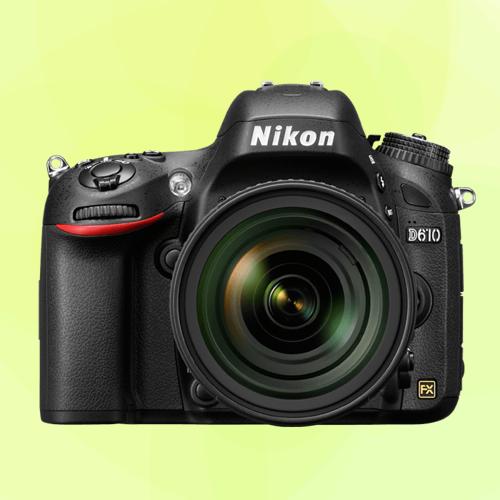
The Nikon D610 is a full-frame DSLR camera aimed at enthusiast photographers seeking excellent image quality and performance without the high price tag of professional-level cameras.
See current price and more information on:
Key specifications:
- 24.3-megapixel full-frame CMOS sensor
- EXPEED 3 image processor
- 39-point autofocus system with 9 cross-type points
- ISO range of 100-6,400 (expandable to 50-25,600)
- Full HD 1080p video recording at 30p, 25p, and 24p
- 6 fps continuous shooting
- 3.2-inch fixed LCD screen with 921k dots
- Dual SD card slots
- Built-in HDR and time-lapse photography capabilities
- Weather-sealed body
Comparisons:
-
Nikon D610 vs Nikon D600: The D610 offers a few improvements over its predecessor, the D600, such as a slightly faster continuous shooting rate (6 fps vs 5.5 fps) and a new quiet continuous shooting mode. Both cameras share the same sensor, image processor, and overall design, but the D610 addressed some shutter issues found in the D600.
-
Nikon D610 vs Canon EOS 6D: Both cameras are entry-level full-frame DSLRs with similar specifications. The D610 has a higher resolution sensor (24.3 MP vs 20.2 MP), a more advanced 39-point AF system (compared to the 6D’s 11-point system with only one cross-type point), and a faster continuous shooting rate (6 fps vs 4.5 fps). The EOS 6D, however, offers built-in Wi-Fi and GPS capabilities, a slightly lighter body, and better low-light performance with a higher maximum ISO (expandable to 102,400).
-
Nikon D610 vs Nikon D750: The D750 is a more advanced full-frame DSLR with several notable upgrades compared to the D610. It features a 24.3-megapixel sensor, an advanced 51-point AF system with 15 cross-type points, and an EXPEED 4 image processor. The D750 offers a tilting LCD screen, faster continuous shooting rate (6.5 fps), and better low-light performance with an ISO range up to 12,800 (expandable to 51,200). The D610, however, is more affordable, making it an attractive option for those seeking a full-frame DSLR at a lower price point.
Sony
Watch out for fraudulant and scam listings. They will often be for exactly $500 or the shipping price will be overly expensive. Sold Listings $400-$500 Sony Cameras
Sony ZV-1
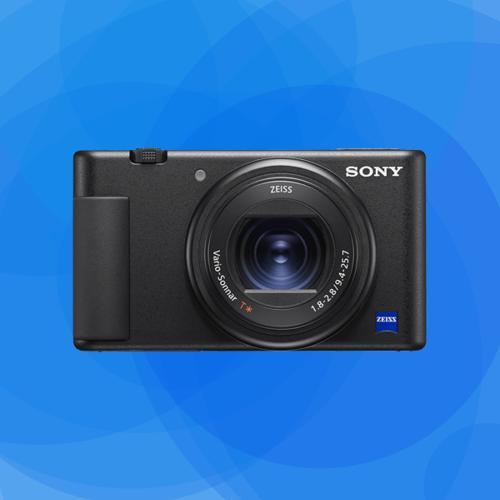
The Sony ZV-1 is a compact digital camera specifically designed for content creators and vloggers who are looking for a versatile and portable option that offers excellent image quality and advanced video features.
See current price and more information on:
Key specifications:
- 20.1-megapixel 1-inch Exmor RS CMOS sensor
- BIONZ X image processor
- 24-70mm equivalent f/1.8-2.8 Zeiss Vario-Sonnar T* lens
- Fast Hybrid AF with 315 phase-detection points and Real-time Eye AF
- ISO range of 100-12,800 (expandable to 64-25,600 for stills)
- 4K UHD video recording at 30p and Full HD 1080p video recording up to 120p
- High-speed continuous shooting up to 24 fps
- 3-inch vari-angle touchscreen LCD with 921k dots
- Built-in electronic viewfinder (EVF) with 2.36 million dots
- Built-in Wi-Fi, NFC, and Bluetooth connectivity
- Directional 3-capsule microphone with a windscreen, and a 3.5mm mic input
- Compact and lightweight design with a comfortable grip
Comparisons:
-
Sony ZV-1 vs Canon G7 X Mark III: Both cameras are aimed at content creators and vloggers and feature 20-megapixel 1-inch sensors. The ZV-1 offers a faster and more accurate autofocus system with 315 phase-detection points and Real-time Eye AF. The ZV-1 also has better audio capabilities, thanks to its directional 3-capsule microphone and windscreen. The Canon G7 X Mark III, on the other hand, offers a slightly longer zoom range (24-100mm equivalent) and livestreaming capabilities.
-
Sony ZV-1 vs Sony RX100 VII: The ZV-1 and RX100 VII share the same sensor, image processor, and autofocus system. The RX100 VII has a longer 24-200mm equivalent zoom range, an integrated pop-up electronic viewfinder, and a slightly more compact design. However, the ZV-1 is specifically tailored to content creators and vloggers, featuring a vari-angle touchscreen, better audio capabilities, and a more accessible price point.
-
Sony ZV-1 vs Panasonic Lumix G100: The Panasonic G100 is a Micro Four Thirds mirrorless camera targeted at vloggers and content creators. It features a 20.3-megapixel sensor, a fully articulating touchscreen, and a built-in electronic viewfinder. The G100’s interchangeable lens system offers more flexibility, but the ZV-1’s autofocus system is faster and more accurate, and its built-in lens has a wider aperture range for better low-light performance.
The Sony ZV-1 is a popular choice for content creators and vloggers due to its excellent image quality, advanced video features, and portable design. Its fast and accurate autofocus system, high-quality built-in microphone, and vari-angle touchscreen make it well-suited for a wide range of content creation scenarios.
Sony A6000

The Sony a6000 is a mirrorless camera aimed at photographers looking for a compact and versatile option that offers excellent image quality, performance, and features.
See current price and more information on:
Key specifications:
- 24.3-megapixel APS-C CMOS sensor
- BIONZ X image processor
- 179-point hybrid autofocus system with 25 contrast-detection points
- ISO range of 100-25,600
- Full HD 1080p video recording at 60p, 30p, and 24p
- 11 fps continuous shooting with autofocus and auto-exposure
- 3-inch tilting LCD screen with 921k dots
- Built-in electronic viewfinder (EVF) with 1.44 million dots
- Built-in Wi-Fi and NFC connectivity
- Compact and lightweight design
Comparisons:
-
Sony a6000 vs Sony a6300: The a6300 is a more advanced camera that offers several improvements over the a6000, such as 4K video recording, a more robust 425-point hybrid autofocus system, a magnesium alloy body with better weather sealing, and a slightly higher-resolution EVF. However, the a6000 offers a more affordable price point while still delivering excellent image quality and performance.
-
Sony a6000 vs Canon EOS M50: Both cameras are aimed at enthusiast photographers and feature 24-megapixel APS-C sensors. The a6000 has a faster and more extensive hybrid autofocus system with 179 points, compared to the M50’s 143-point Dual Pixel AF system. The a6000 also offers a faster continuous shooting rate at 11 fps. The Canon M50, on the other hand, has 4K video capabilities (albeit with a significant crop factor) and a fully articulating touchscreen.
-
Sony a6000 vs Fujifilm X-T20: The Fujifilm X-T20 is another mirrorless camera aimed at enthusiast photographers, featuring a 24.3-megapixel APS-C X-Trans CMOS III sensor and the X-Processor Pro image processor. The X-T20 offers 4K video recording, a fully articulating touchscreen, and a retro design with dedicated dials for exposure settings. The Sony a6000, however, has a more extensive autofocus system and faster continuous shooting.
The Sony a6000 is a popular choice for photographers looking for a compact, versatile, and feature-rich mirrorless camera that offers excellent image quality and performance. Its 24.3-megapixel sensor, fast hybrid autofocus system, and 11 fps continuous shooting make it well-suited for a wide range of photography styles, from street and travel to portraits and sports.
Fujifilm
Watch out for fraudulant and scam listings. They will often be for exactly $500 or the shipping price will be overly expensive. Sold Listings $400-$500 Fujifilm Cameras
Fujifilm X-T20
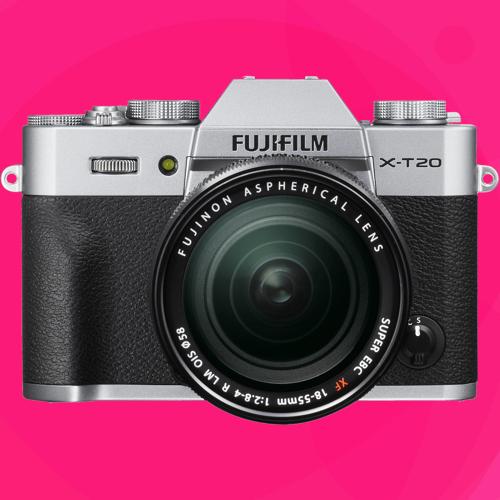
The Fujifilm X-T20 is a mirrorless camera aimed at photographers seeking a compact, versatile, and stylish option that offers excellent image quality, performance, and features.
See current price and more information on:
Key specifications:
- 24.3-megapixel APS-C X-Trans CMOS III sensor
- X-Processor Pro image processor
- 91-point hybrid autofocus system with 49 phase-detection points
- ISO range of 200-12,800 (expandable to 100-51,200)
- 4K UHD video recording at 30p, 25p, and 24p
- 8 fps continuous shooting with autofocus and auto-exposure (up to 14 fps with electronic shutter)
- 3-inch tilting touchscreen LCD with 1.04 million dots
- Built-in electronic viewfinder (EVF) with 2.36 million dots
- Film Simulation modes to emulate the look of classic Fujifilm film stocks
- Wi-Fi connectivity
- Retro design with dedicated dials for exposure settings
Comparisons:
-
Fujifilm X-T20 vs Fujifilm X-T10: The X-T20 offers several improvements over its predecessor, the X-T10, such as a higher resolution 24.3-megapixel sensor, 4K video recording, a touchscreen LCD, and a faster continuous shooting rate (8 fps vs 6 fps). Both cameras share a similar retro design and overall handling experience.
-
Fujifilm X-T20 vs Sony a6000: Both cameras are aimed at enthusiast photographers and feature 24-megapixel APS-C sensors. The X-T20 offers 4K video recording, a tilting touchscreen, and a retro design with dedicated dials for exposure settings. The Sony a6000, however, has a more extensive autofocus system with 179 hybrid AF points and faster continuous shooting at 11 fps.
-
Fujifilm X-T20 vs Fujifilm X-T30: The X-T30 is an upgraded version of the X-T20, featuring a 26.1-megapixel APS-C X-Trans CMOS 4 sensor and the X-Processor 4 image processor. It has a more advanced 425-point hybrid autofocus system, improved Face and Eye Detection AF, and 4K video recording at 30p with 10-bit 4:2:2 output via HDMI. The X-T20, on the other hand, offers a more affordable price point while still delivering excellent image quality and performance.
Fujifilm X-T2
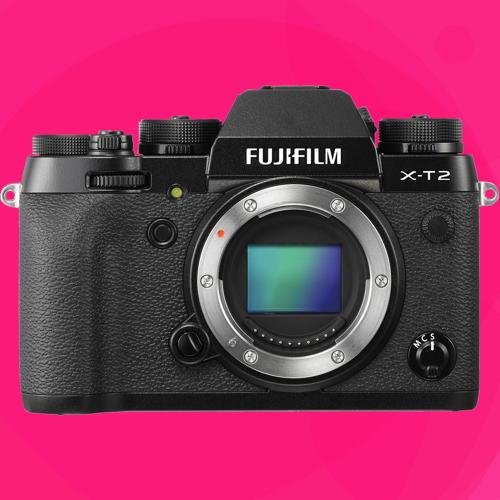
The Fujifilm X-T2 is a mirrorless camera aimed at enthusiast and professional photographers who seek a high-performance, versatile, and stylish option that delivers excellent image quality and advanced features.
See current price and more information on:
Key specifications:
- 24.3-megapixel APS-C X-Trans CMOS III sensor
- X-Processor Pro image processor
- 325-point hybrid autofocus system with 169 phase-detection points
- ISO range of 200-12,800 (expandable to 100-51,200)
- 4K UHD video recording at 30p, 25p, and 24p
- 8 fps continuous shooting with autofocus and auto-exposure (up to 14 fps with electronic shutter)
- 3-inch tilting LCD screen with 1.04 million dots
- Built-in electronic viewfinder (EVF) with 2.36 million dots and 0.77x magnification
- Film Simulation modes to emulate the look of classic Fujifilm film stocks
- Wi-Fi connectivity
- Weather-resistant body with magnesium alloy construction
- Retro design with dedicated dials for exposure settings
Comparisons:
-
Fujifilm X-T2 vs Fujifilm X-T1: The X-T2 offers several improvements over its predecessor, the X-T1, such as a higher resolution 24.3-megapixel sensor, 4K video recording, a faster and more extensive autofocus system, and a dual-hinged tilting LCD screen. The X-T2 also has a slightly better EVF with a higher refresh rate and improved performance in low light.
-
Fujifilm X-T2 vs Fujifilm X-T3: The X-T3 is an upgraded version of the X-T2, featuring a 26.1-megapixel APS-C X-Trans CMOS 4 sensor, the X-Processor 4 image processor, and a more advanced 425-point hybrid autofocus system. The X-T3 offers 4K video recording at 60p with 10-bit 4:2:2 output via HDMI and a faster continuous shooting rate (11 fps with mechanical shutter, or 20 fps with electronic shutter). However, the X-T2 remains a solid choice for those seeking high-quality performance at a more affordable price point.
-
Fujifilm X-T2 vs Sony a7 II: The Sony a7 II is a full-frame mirrorless camera, offering a larger sensor and better low-light performance. However, the X-T2 has a more advanced autofocus system, 4K video recording capabilities, a faster continuous shooting rate, and the unique Film Simulation modes. The X-T2’s APS-C sensor also allows for a more compact and lightweight system when compared to full-frame alternatives.
Panasonic
Sold Listings $400-$500 Panasonic Cameras
Panasonic GH4
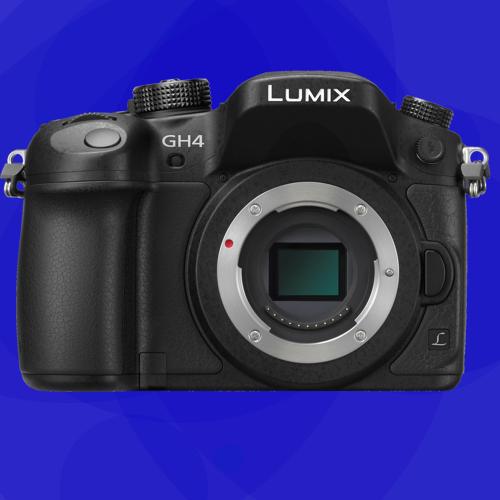
The Panasonic GH4 is a mirrorless camera aimed at photographers and videographers seeking a high-performance, versatile, and feature-rich option that delivers excellent image quality and advanced video capabilities.
See current price and more information on:
Key specifications:
- 16.05-megapixel Micro Four Thirds Live MOS sensor
- Venus Engine 9 image processor
- 49-point contrast-detection autofocus system
- ISO range of 200-25,600 (expandable to 100-25,600)
- 4K UHD video recording at 30p, 25p, and 24p
- Full HD 1080p video recording up to 96p
- 12 fps continuous shooting with autofocus and auto-exposure
- 3-inch fully articulating touchscreen OLED with 1.04 million dots
- Built-in electronic viewfinder (EVF) with 2.36 million dots and 0.67x magnification
- Wi-Fi connectivity with NFC
- Magnesium alloy body with weather-sealing
Comparisons:
-
Panasonic GH4 vs Panasonic GH3: The GH4 offers several improvements over its predecessor, the GH3, such as 4K video recording, a faster continuous shooting rate (12 fps vs 6 fps), and a more extensive ISO range. The GH4 also has a higher-resolution EVF and a more durable magnesium alloy body.
-
Panasonic GH4 vs Panasonic GH5: The GH5 is an upgraded version of the GH4, featuring a 20.3-megapixel sensor, 5-axis in-body image stabilization, and more advanced video capabilities such as 4K 60p recording and 10-bit 4:2:2 internal recording. The GH5 also has a more advanced 225-area contrast-detection autofocus system. However, the GH4 remains a solid choice for those seeking 4K video capabilities at a more affordable price point.
-
Panasonic GH4 vs Sony a7S: The Sony a7S is a full-frame mirrorless camera known for its exceptional low-light performance and video capabilities. While both cameras offer 4K video recording, the a7S requires an external recorder for 4K, whereas the GH4 can record 4K internally. The a7S has a larger sensor, which provides better low-light performance and a shallower depth of field. However, the GH4 has a faster continuous shooting rate and a smaller, lighter form factor due to its Micro Four Thirds sensor.
Panasonic G85
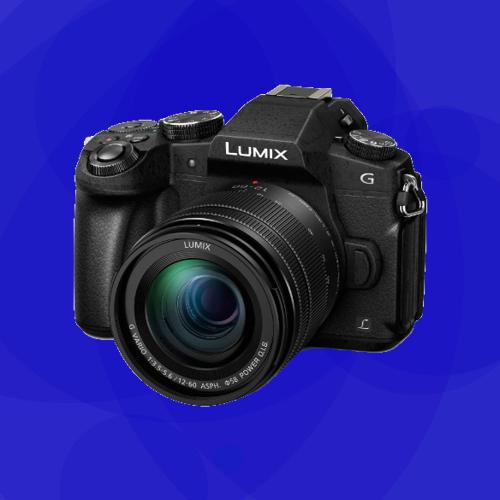
The Panasonic G85 (also known as the G80 in some regions) is a mirrorless camera aimed at photographers and videographers seeking a high-performance, versatile, and feature-rich option that delivers excellent image quality and advanced features in a compact form factor.
See current price and more information on:
Key specifications:
- 16-megapixel Micro Four Thirds Live MOS sensor
- Venus Engine 9 image processor
- 49-point contrast-detection autofocus system with Depth From Defocus (DFD) technology
- ISO range of 200-25,600 (expandable to 100-25,600)
- 4K UHD video recording at 30p and 24p
- Full HD 1080p video recording up to 60p
- 5-axis in-body image stabilization
- 9 fps continuous shooting with autofocus and auto-exposure (6 fps with continuous AF)
- 3-inch fully articulating touchscreen LCD with 1.04 million dots
- Built-in electronic viewfinder (EVF) with 2.36 million dots and 0.74x magnification
- Wi-Fi connectivity
- Weather-sealed body
Comparisons:
-
Panasonic G85 vs Panasonic G7: The G85 offers several improvements over its predecessor, the G7, such as 5-axis in-body image stabilization, a weather-sealed body, and a more advanced shutter mechanism that reduces shutter shock. Both cameras share a similar design, 16-megapixel sensor, and 4K video capabilities.
-
Panasonic G85 vs Panasonic GH4: While the GH4 is more video-centric with features like 4K UHD video recording at higher frame rates and a headphone jack, the G85 provides a more balanced feature set for both photography and videography. The G85 offers 5-axis in-body image stabilization, a more compact form factor, and a weather-sealed body, making it better suited for photographers who need a versatile camera for various shooting scenarios.
-
Panasonic G85 vs Olympus OM-D E-M5 Mark II: Both cameras feature weather-sealed bodies, 5-axis in-body image stabilization, and Micro Four Thirds sensors. The Olympus E-M5 Mark II has a 40-megapixel High-Resolution mode, while the G85 has 4K video capabilities and Panasonic’s Depth From Defocus autofocus system, which may provide faster AF performance in certain situations.
The Panasonic G85 is a popular choice for photographers and videographers looking for a high-performance, versatile, and feature-rich mirrorless camera that offers excellent image quality and advanced features in a compact, weather-sealed body. Its 16-megapixel sensor, 5-axis in-body image stabilization, and 4K video capabilities make it well-suited for a wide range of photography and videography styles, from travel and documentary to portraits and events.
Olympus
Sold Listings $400-$500 Olympus Cameras
Olympus TG-6
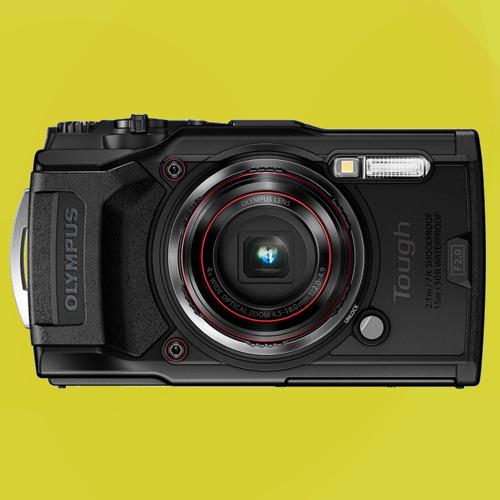
The Olympus TG-6 is a rugged compact camera aimed at photographers seeking a durable and versatile option that can withstand harsh conditions while delivering good image quality and features.
See current price and more information on:
Key specifications:
- 12-megapixel 1/2.3-inch BSI CMOS sensor
- TruePic VIII image processor
- 4x optical zoom (25-100mm equivalent, f/2.0-4.9)
- ISO range of 100-12,800
- Sensor-shift image stabilization
- Autofocus with target tracking and face detection
- 4K UHD video recording at 30p
- Full HD 1080p video recording up to 120p
- 20 fps continuous shooting
- 3-inch fixed LCD with 1.04 million dots
- Built-in GPS, Wi-Fi, and compass
- Waterproof (50ft/15m), shockproof (7ft/2.1m), crushproof (220 lbs/100 kg), freezeproof (14°F/-10°C), and dustproof
Comparisons:
-
Olympus TG-6 vs Olympus TG-5: The TG-6 offers several improvements over its predecessor, the TG-5, such as a higher-resolution rear LCD, a new underwater white balance mode, and better macro capabilities with focus stacking and focus bracketing. Both cameras share a similar design, sensor, and rugged capabilities.
-
Olympus TG-6 vs Panasonic Lumix FT7 (TS7): Both cameras are rugged compacts designed for harsh conditions. While the Panasonic FT7 features a higher-resolution 20.4-megapixel sensor and an electronic viewfinder, the Olympus TG-6 has a faster lens (f/2.0 at the wide end) and better macro capabilities. The TG-6 also offers focus stacking and focus bracketing, which are not available on the FT7.
-
Olympus TG-6 vs Nikon Coolpix W300: Both cameras are rugged and waterproof, but the Nikon W300 offers a slightly deeper waterproof rating (100ft/30m) and a 5x optical zoom range (24-120mm equivalent). The Olympus TG-6, on the other hand, has a faster lens (f/2.0 at the wide end) and better macro capabilities with focus stacking and focus bracketing. Additionally, the TG-6 offers a more extensive ISO range, which can be useful in low-light conditions.
Olympus PEN E-PL10
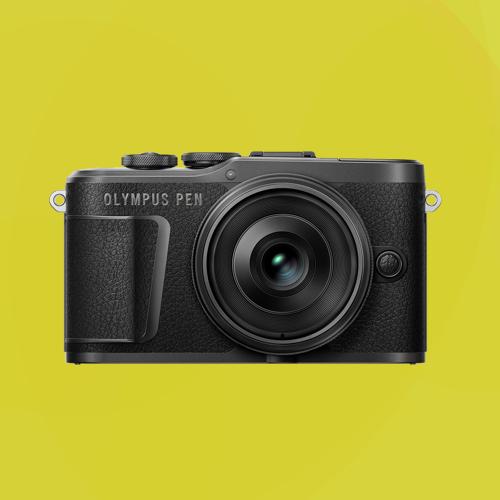
The Olympus PEN E-PL10 is a mirrorless camera aimed at photographers seeking a stylish, compact, and versatile option that delivers good image quality and features in an easy-to-use package.
See current price and more information on:
Key specifications:
- 16.1-megapixel Micro Four Thirds Live MOS sensor
- TruePic VIII image processor
- 121-point contrast-detection autofocus system
- ISO range of 200-25,600 (expandable to 100-25,600)
- In-body 3-axis image stabilization
- 4K UHD video recording at 30p and 24p
- Full HD 1080p video recording up to 60p
- 8.6 fps continuous shooting with autofocus and auto-exposure
- 3-inch 180-degree tilting touchscreen LCD with 1.04 million dots
- Built-in Wi-Fi and Bluetooth connectivity
- Stylish, compact, and lightweight design
Comparisons:
-
Olympus PEN E-PL10 vs Olympus PEN E-PL9: The E-PL10 is a minor upgrade over its predecessor, the E-PL9. Both cameras share a similar design, sensor, and feature set. The E-PL10 offers an improved grip and an updated art filter called “Instant Film,” but overall, the differences between the two models are minimal.
-
Olympus PEN E-PL10 vs Olympus OM-D E-M10 Mark III: Both cameras feature a 16.1-megapixel Micro Four Thirds sensor, TruePic VIII image processor, and in-body image stabilization. The E-M10 Mark III has a built-in electronic viewfinder (EVF) and a more advanced 121-point autofocus system, while the E-PL10 is more compact and lightweight, making it more suitable for casual photography and travel.
-
Olympus PEN E-PL10 vs Panasonic Lumix GX850 (GX800): Both cameras are compact and stylish Micro Four Thirds options. The Panasonic GX850 has a higher-resolution 16-megapixel sensor and 4K Photo modes, which allow users to extract 8-megapixel stills from 4K video. The Olympus E-PL10, on the other hand, offers in-body 3-axis image stabilization and a more extensive range of art filters, making it more appealing to those looking for creative options in-camera.